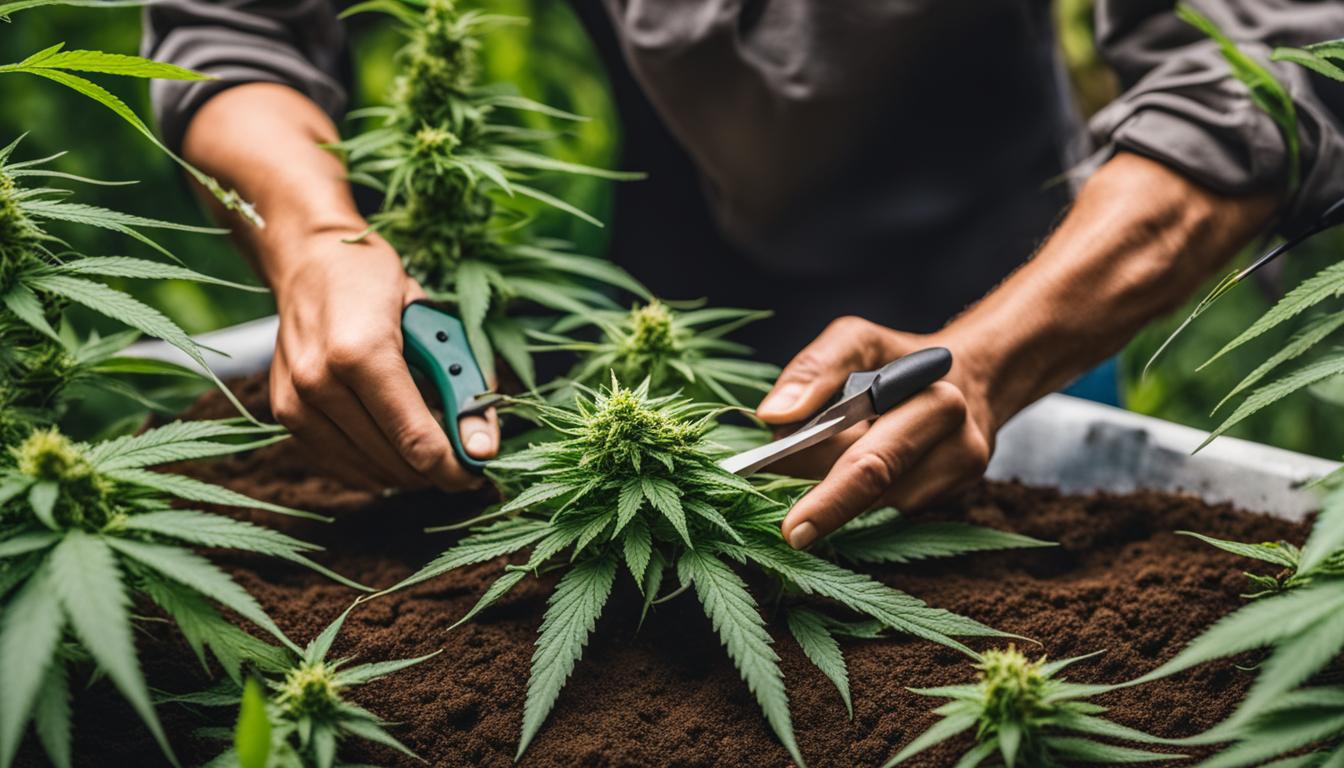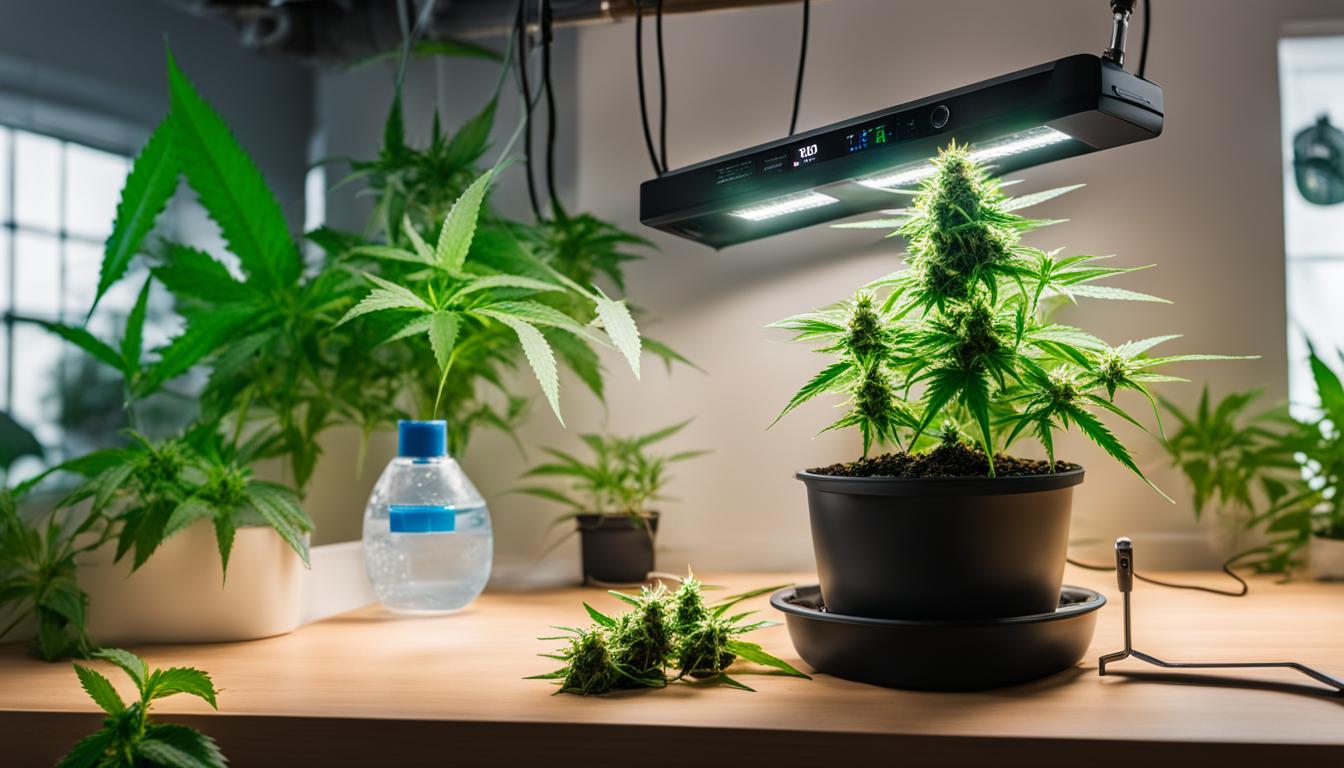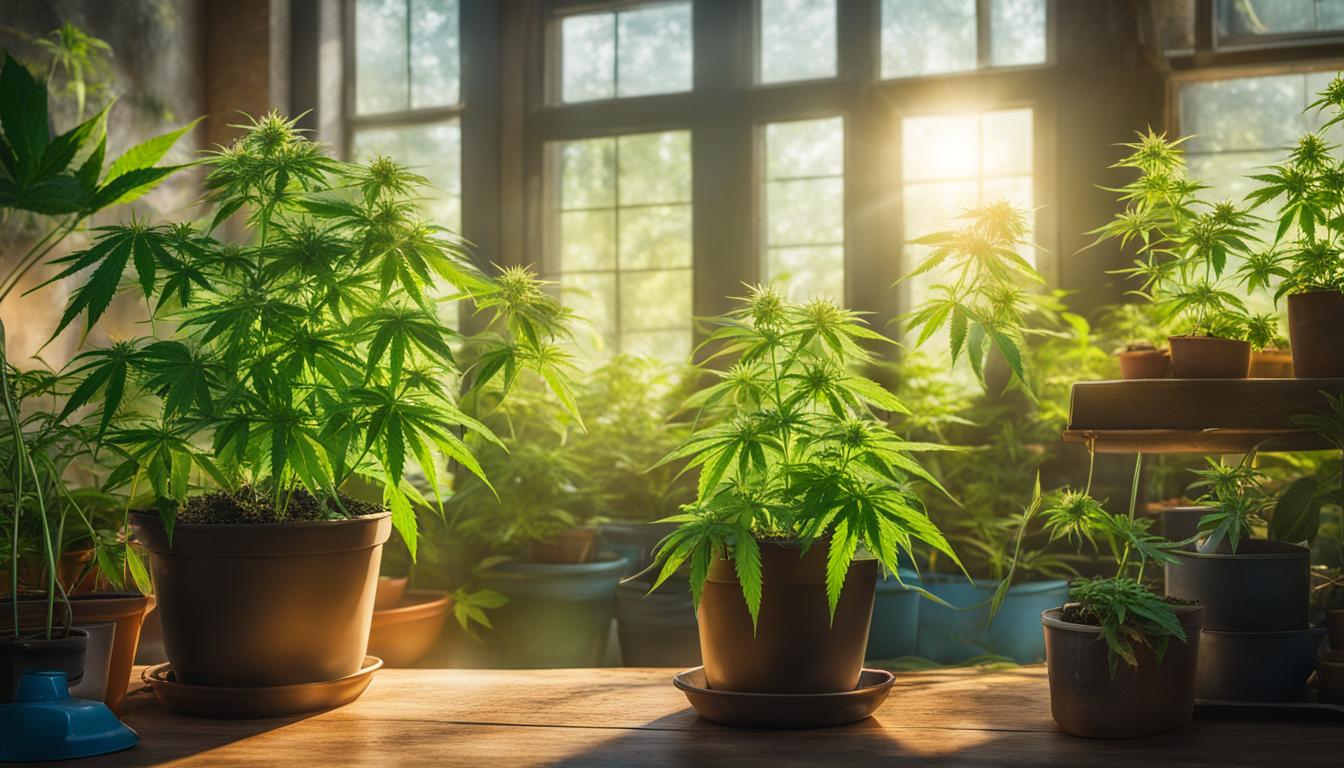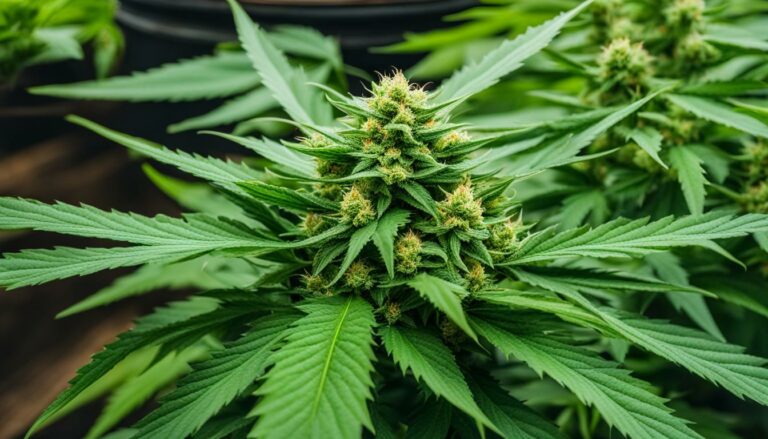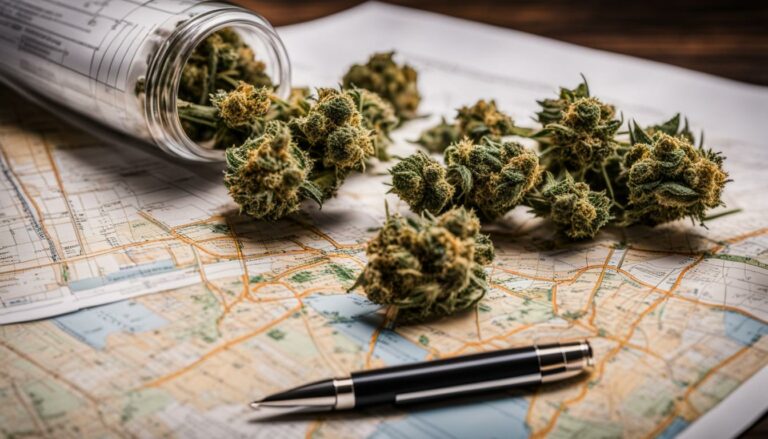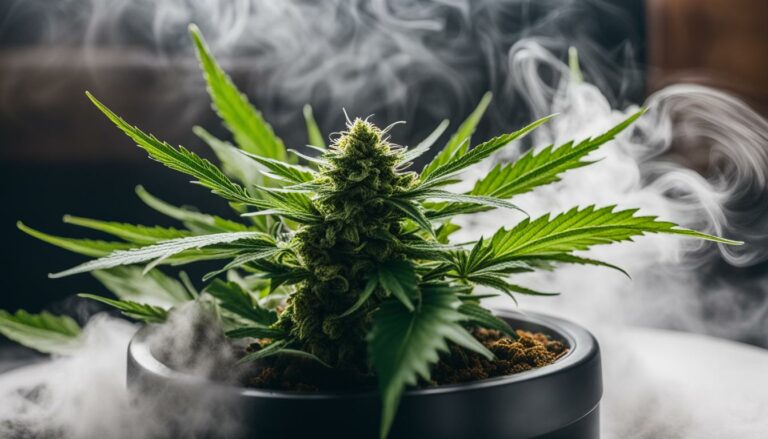The Art of Pruning Cannabis Plants
Pruning cannabis is an essential practice that can transform your cultivation game. With the right techniques, you can optimize the yield and potency of your plants, ensuring a bountiful harvest of high-quality buds. If you’re wondering how to prune cannabis plants, look no further. This in-depth guide will equip you with the knowledge and skills to master the art of pruning marijuana.
Pruning cannabis involves strategically trimming away specific parts of the plant, such as leaves and branches, to promote growth and redirect the plant’s energy. This practice not only maximizes the yield but also enhances airflow, light exposure, and overall plant health. By understanding the when, how, and why of pruning, you can shape your cannabis plants into thriving beauties.
In this comprehensive guide, we’ll explore the various pruning techniques, the ideal times to prune, and the tools you’ll need to get the job done. We’ll delve into the benefits of pruning cannabis and address common concerns and FAQs. Whether you’re a seasoned grower or a novice cultivator, this guide will provide you with the knowledge and confidence to achieve the best results.
So, let’s dive into the world of pruning cannabis plants and discover the secrets to unlocking their full potential. Get ready to elevate your cultivation skills and watch your cannabis plants thrive like never before.
Why Prune Cannabis?
Pruning cannabis plants is a crucial practice that offers a multitude of benefits for growers. By strategically removing specific parts of the plant, such as leaves, stems, and branches, growers can promote growth and maximize yield. Pruning redirects the plant’s energy to its flowering sites, resulting in larger and more potent buds. It also enhances airflow and light exposure, reducing the risk of mold and pests. Through pruning, growers can ensure that each bud receives optimal nourishment, leading to higher-quality harvests.
One of the key benefits of pruning cannabis is the ability to shape the plant’s growth. By selectively removing leaves and non-essential branches, growers can redirect the plant’s energy towards the desired areas. This allows for more efficient use of nutrients and resources, ultimately resulting in healthier and more vigorous growth. Pruning also helps to create a more open canopy, allowing light to penetrate deep into the plant, leading to increased bud development and overall yield.
“Pruning redirects the plant’s energy to its flowering sites, resulting in larger and more potent buds.”
Additionally, proper pruning techniques can help maintain the overall health and vitality of the cannabis plant. By removing overcrowded or diseased foliage, growers can improve airflow within the canopy, reducing the risk of mold and mildew. Pruning also creates a more manageable plant structure, making it easier to monitor and address any issues that may arise during the cultivation process. By regularly pruning and maintaining the plant, growers can optimize the overall health, growth, and yield of their cannabis crop.
Table: Benefits of Pruning Cannabis
| Benefits | Explanation |
|---|---|
| Promotes growth | Redirects the plant’s energy to desired areas, resulting in healthier and more vigorous growth. |
| Maximizes yield | By shaping the plant’s growth and creating an open canopy, pruning allows for increased bud development and overall yield. |
| Enhances airflow and light exposure | Pruning reduces the risk of mold and pests by improving airflow within the canopy and allowing light to penetrate deep into the plant. |
| Improves overall plant health | Regular pruning helps maintain the plant’s overall health and vitality by removing overcrowded or diseased foliage. |
When to Start Pruning Cannabis?
Pruning cannabis plants at the right time is crucial for ensuring optimal growth and development. The ideal stage to start pruning is during the vegetative stage, which typically occurs from around week 3 to week 16 of the plant’s life cycle. However, it is important not to rush into pruning too early, as this can negatively impact the plant’s growth.
During the vegetative stage, it is recommended to wait until the plant has grown a sturdy stem and multiple sets of leaves before starting to prune. This ensures that the plant has established a strong foundation and is better equipped to handle the stress of pruning. As the plant continues to mature during the vegetative stage, more aggressive pruning can be done to shape its growth.
Understanding the different growth phases of cannabis plants is essential to determine the ideal times to intervene and guide their development. By starting the pruning process at the right time and using appropriate techniques, growers can promote healthy growth, maximize yield, and achieve the desired shape and structure for their cannabis plants.
“The ideal stage to start pruning cannabis plants is during the vegetative stage.”
| Growth Phase | Timeframe |
|---|---|
| Vegetative Stage | Week 3 to Week 16 |
| Flowering Stage | Week 16 to Harvest |
Using the Right Tools for Pruning Cannabis
When it comes to pruning cannabis plants, having the right tools is essential for achieving optimal results. High-quality pruning tools can make the task easier, more efficient, and ultimately lead to healthier plants and increased yields. Here are some of the essential tools you need for pruning cannabis:
1. Pruning Shears
Pruning shears are a must-have tool for any cannabis grower. These handheld scissors are designed with sharp, precision blades that make clean cuts without causing damage to the plant. Look for pruning shears with a comfortable grip and a locking mechanism to ensure safe and easy use.
2. Precision-Tip Pruning Scissors
Precision-tip pruning scissors are smaller, more delicate scissors that are ideal for trimming small leaves and delicate branches. These scissors allow for more precision and control when pruning, ensuring that you can target specific areas without damaging the surrounding foliage.
3. Sterilization
Before and after each use, it’s important to sterilize your pruning tools to prevent the spread of diseases and pests. You can use rubbing alcohol or a diluted bleach solution to clean and disinfect your tools thoroughly. This simple step can help maintain the health of your plants and prevent the introduction of harmful pathogens.
4. Gloves
Wearing gloves while pruning cannabis is not only for your protection but also for the plants. Gloves help prevent the transfer of oils and contaminants from your hands onto the plants, reducing the risk of infection. Additionally, gloves can protect your hands from sticky resin and make cleanup easier.
Investing in high-quality pruning tools, such as pruning shears and precision-tip pruning scissors, can significantly improve your pruning techniques and ensure the health and vitality of your cannabis plants. Remember to regularly clean and sterilize your tools and wear protective gloves to create the optimal pruning environment.
Different Pruning Techniques for Cannabis
Pruning cannabis offers growers the opportunity to shape the plant’s growth and maximize yield. It involves various techniques that serve different purposes. Let’s explore some of the most common pruning methods:
Pruning vs Topping
Pruning and topping are two distinct techniques. Pruning focuses on selectively removing leaves and non-essential branches, redirecting the plant’s energy to critical areas. On the other hand, topping involves cutting off the top of the main stem to stimulate the growth of two main stems. Both methods can be used effectively depending on the desired outcome and the stage of cannabis growth.
Lollipopping
Lollipopping is a specialized pruning technique that involves removing the lower one-third of the plant’s branches and foliage. This technique helps to concentrate the plant’s energy on the upper branches, where the majority of the buds will develop. By removing the lower foliage, lollipopping promotes airflow and prevents energy wastage on non-essential growth. Lollipopping is particularly beneficial for indoor cultivators who want to maximize their bud sites in limited vertical space.
Pruning Methods to Increase Bud Sites
There are several pruning methods that growers can employ to increase the number of bud sites on their cannabis plants. Some of these methods include:
- Low-Stress Training (LST): Gently bending the branches of the plant to encourage lateral growth and the formation of additional bud sites.
- Super Cropping: Applying controlled stress to specific points on the plant’s stem to stimulate the growth of new nodes and bud sites.
- Scrogging: Using a screen or net to train the plant’s branches to grow horizontally, creating an even canopy and maximizing bud development.
Emphasizing Energy Redirection for Maximum Yield
Ultimately, the goal of pruning cannabis is to redirect the plant’s energy to the most productive areas, resulting in larger, denser buds and increased overall yield. By selectively removing foliage and branches, growers can ensure that the plant’s resources are focused on developing and nourishing the most promising bud sites. It’s important to consider the specific needs of each strain and adjust the pruning techniques accordingly, keeping in mind that some cannabis plants may respond better to certain methods than others.
| Pruning Technique | Purpose |
|---|---|
| Pruning | Selective removal of leaves and non-essential branches to redirect energy |
| Topping | Cutting off the top of the main stem to promote the growth of two main stems |
| Lollipopping | Removing lower branches and foliage to concentrate energy on upper branches |
| Low-Stress Training (LST) | Gently bending branches for lateral growth and more bud sites |
| Super Cropping | Applying controlled stress to stimulate the growth of new nodes and bud sites |
| Scrogging | Using a screen or net to create an even canopy and maximize bud development |

Frequency of Pruning Cannabis
Regular pruning during the vegetative stage is crucial for shaping cannabis plants and promoting desired growth patterns. During this stage, plants are focused on developing a strong structure, and pruning helps guide their growth in the right direction. Pruning can be done every week or two, depending on the plant’s growth rate and overall health. However, it is important not to over-prune, as this can cause stress and hinder the plant’s development.
As the cannabis plant transitions into the flowering stage, pruning should be done with caution and decreased in frequency. At this stage, the plant’s energy is primarily focused on bud development, and major changes to its structure can be disruptive. It is advisable to only perform light pruning during the flowering stage, such as removing yellowing leaves or small lower branches that are not receiving adequate light.
Over-pruning can negatively impact the plant’s overall health and yield. It is crucial to strike a balance between shaping the plant and allowing it to thrive naturally. Observing the plant’s response to pruning is important, as every cannabis strain may react differently. By monitoring the plant’s growth and adjusting pruning frequency accordingly, growers can ensure healthy and productive cannabis plants.
| Stage | Frequency of Pruning |
|---|---|
| Vegetative | Every week or two, depending on growth rate and health |
| Flowering | Light pruning, only as necessary for plant health |
“Pruning cannabis plants requires careful consideration of the plant’s growth stage and needs. While regular pruning during the vegetative stage can help shape the plant and guide its growth, it is important to decrease pruning frequency during flowering to avoid undue stress. Remember, a healthy plant with proper pruning will reward you with robust growth and optimal bud development.”
Frequently Asked Questions about Pruning Cannabis
Pruning cannabis plants can be a complex process, and growers often have questions about various aspects of it. In this section, we address some key FAQs to help you navigate the world of cannabis pruning.
Recovery After Pruning
One common concern among growers is how long it takes for a cannabis plant to recover after pruning. Light pruning, such as removing a few leaves or small branches, typically leads to a speedy recovery within a few days to a week. However, more aggressive pruning, such as topping or extensive defoliation, may require up to two weeks for the plant to bounce back fully.
Concerns about Over-Defoliation
Over-defoliation, or removing too many leaves, can be detrimental to a cannabis plant’s health and productivity. Leaves play a crucial role in photosynthesis, absorbing and converting light into energy. If too many leaves are removed, the plant may struggle to produce enough energy to support its growth. It is important to strike a balance between removing excess foliage for better airflow and light penetration and ensuring that the plant has enough leaves to sustain its growth.
Pruning Above or Below a Leaf?
When pruning cannabis, an essential consideration is whether to make cuts above or below a leaf. The general rule of thumb is to make cuts just above the node where the leaf or branch connects to the main stem. This method helps promote healing and prevents the development of unsightly stubs. By making clean cuts above the node, you ensure that the plant can easily recover and continue its growth without unnecessary stress.
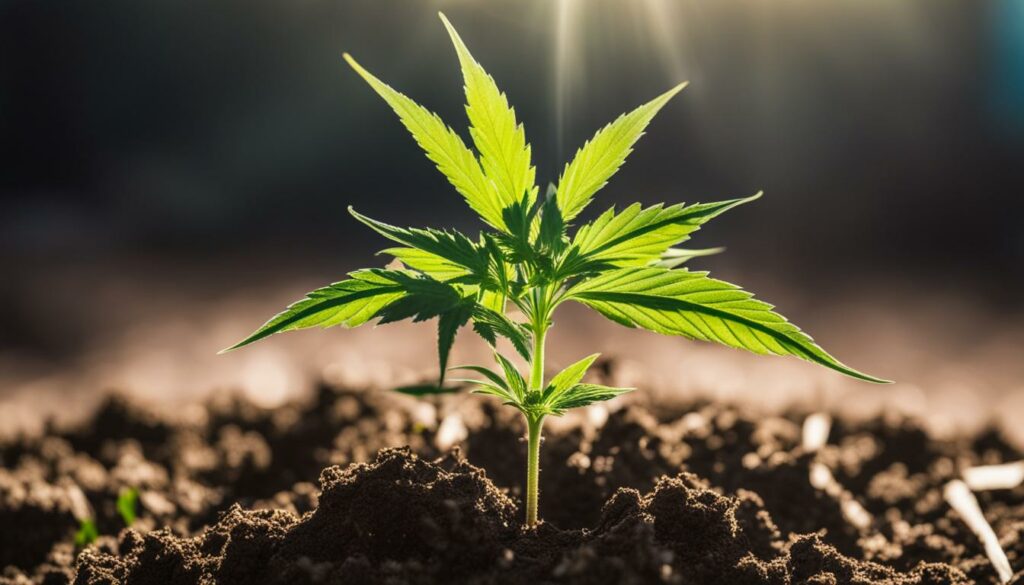
Summary:
- Light pruning typically results in a quick recovery within a few days to a week.
- Over-defoliation can stress the plant and hinder its ability to photosynthesize effectively.
- Make pruning cuts just above the node where the leaf or branch connects to the main stem to promote healing and prevent stubs.
By understanding these key aspects of pruning cannabis, you can ensure that your plants recover well, avoid over-defoliation, and make cuts in the right location for optimal growth.
The Importance of Proper Trimming Techniques
Proper trimming techniques are fundamental to achieving clean and exceptional cannabis buds. The process involves removing all excess plant material, such as stems, branches, and leaves, leaving only the high-quality buds intact. Trimming not only enhances the visual appeal of the final product, but it also improves the overall smoking experience by eliminating undesirable elements and maximizing the potency of the buds.
When it comes to trimming marijuana plants, there are two main methods: wet trimming and dry trimming. Wet trimming involves pruning the buds immediately after harvest, while they are still fresh and full of moisture. This method allows for easier removal of excess foliage and facilitates faster drying time. On the other hand, dry trimming entails waiting until the buds have dried completely before trimming off the surrounding leaves. This technique helps preserve the terpene content within the buds and results in a smoother trimming process overall.
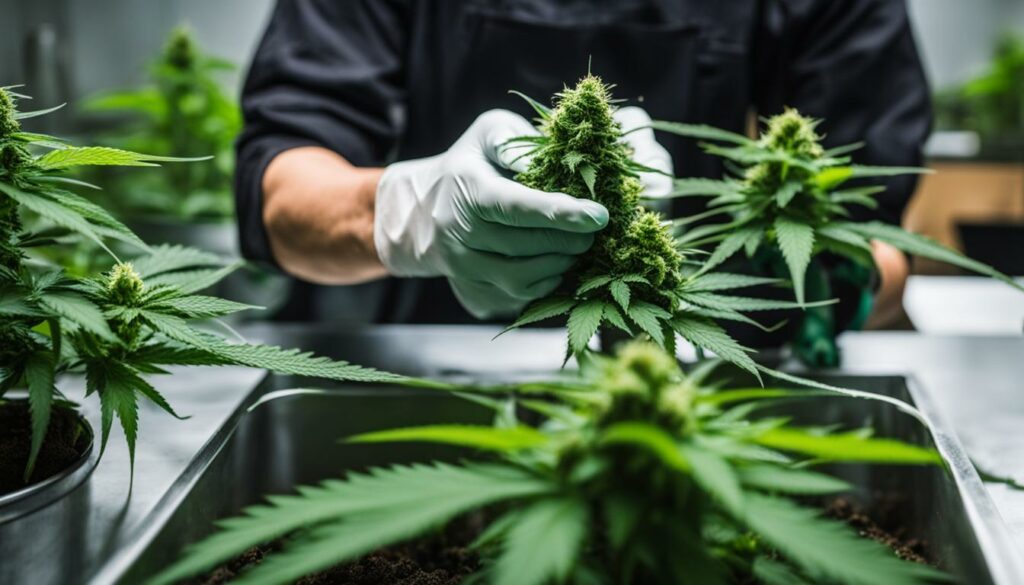
Proper trimming techniques are crucial for ensuring the highest quality cannabis flower.
When it comes to selecting the right trimming tools, it is important to invest in high-quality shears or scissors specifically designed for trimming cannabis. These tools should be sharp and sanitized to prevent any damage to the buds. Maintaining a clean and organized work area is also essential to ensure the buds remain free from contaminants and unwanted debris.
Benefits of Proper Trimming Techniques
Proper trimming techniques offer several benefits to both growers and consumers. Firstly, clean buds not only look more visually appealing, but they are also easier to handle and package. Trimming eliminates excess plant material that can contribute to an unpleasant taste when smoking or consuming cannabis. Additionally, removing unnecessary foliage allows the buds to dry more evenly, resulting in a higher quality end product.
Furthermore, proper trimming techniques help improve the overall potency of the cannabis buds. By removing unwanted leaves and stems, the energy and resources of the plant are redirected towards the development of trichomes, which are responsible for producing cannabinoids and terpenes. This ultimately translates into a more potent and flavorful final product for consumers to enjoy.
| Benefits of Proper Trimming Techniques |
|---|
| Enhanced visual appeal of buds |
| Improved taste and smoking experience |
| Even drying and higher quality end product |
| Increased potency and flavor |
Essential Tools and Tips for Trimming Cannabis
When it comes to trimming cannabis, having the right tools and equipment can make a significant difference in the quality of your final product. Here are some essential tools and tips to ensure a successful trimming process:
Trimming Shears
Investing in a pair of high-quality trimming shears is crucial for achieving precise and clean cuts. Sharp, stainless steel blades will ensure minimal damage to the buds, resulting in a neater and more attractive appearance. It’s also important to regularly sanitize the shears to prevent the spread of contaminants and diseases.
Comfortable Chair
Trimming cannabis can be a time-consuming task, so it’s essential to have a comfortable and supportive chair to sit in during the process. Choose a chair that provides proper back support and cushioning to reduce fatigue and discomfort. This will allow you to focus on the task at hand without any distractions.
Trimming Tray
A trimming tray is a useful tool for keeping the trimming process organized and efficient. It provides a designated space to collect the trimmed buds, preventing them from falling to the ground or getting mixed up with other material. Look for a tray with a non-stick surface to make it easier to gather the trimmed buds.
Cleaning Supplies
Having cleaning supplies readily available is crucial for maintaining cleanliness and hygiene during the trimming process. Keep a supply of alcohol wipes or sanitizing solution to clean your hands and tools regularly. It’s also a good idea to have paper towels or disposable gloves on hand for easy cleanup.
Trimming Clothes
Trimming cannabis can get messy, with sticky resin and plant material getting on your clothes. To protect your clothing and minimize the mess, designate a set of trimming clothes specifically for this task. Choose comfortable and easy-to-clean garments that you don’t mind getting dirty.
By equipping yourself with the right tools and following these tips, you can streamline the trimming process and achieve clean, attractive buds for the best possible cannabis experience.
| Tool | Importance |
|---|---|
| Trimming Shears | Essential for precision cuts and minimal bud damage |
| Comfortable Chair | Provides support and comfort during long trimming sessions |
| Trimming Tray | Keeps trimmed buds organized and prevents loss or mixing |
| Cleaning Supplies | Ensures cleanliness and prevents the spread of contaminants |
| Trimming Clothes | Protects clothing from resin and plant material |
Related Articles
- What Are the Best Pruning Techniques for Cannabis Plants?
- How Does Pruning Affect the Growth and Yield of Cannabis?
- What Are the Dos and Don’ts of Pruning Cannabis?
- Can Pruning Improve the Potency and Quality of Cannabis Buds?
- How to Prune Cannabis Plants for Maximum Light Exposure?
Conclusion
In conclusion, the art of pruning cannabis plants is a crucial aspect of cultivation that can significantly enhance yield and potency. By employing proper pruning techniques, growers can improve the overall health of their plants and increase the size and quality of their harvest. Pruning allows for the redirection of the plant’s energy to its flowering sites, resulting in larger and more potent buds.
Furthermore, pruning provides additional benefits such as improved airflow and light exposure, reducing the risk of mold and pests, and ensuring that each bud receives optimum nourishment. By understanding the different pruning methods and their applications, growers can shape the growth of their cannabis plants to maximize yield and achieve desired outcomes.
It is essential to consider the timing and frequency of pruning. During the vegetative stage, regular pruning can help shape the plant and promote desired growth patterns. However, caution must be exercised not to over-prune, as this may cause undue stress to the plant. As the plant transitions to the flowering stage, pruning should be less frequent to allow for focused energy on bud development.
In summary, proper trimming techniques play a crucial role in producing high-quality cannabis flowers. By using the right tools, such as trimming shears, and understanding the advantages of wet and dry trimming methods, growers can ensure clean and attractive final products. With a comprehensive understanding of pruning and trimming practices, cultivators can unlock the full potential of their cannabis plants and achieve optimal results.
FAQ
Why is pruning cannabis important?
Pruning cannabis is important because it promotes growth, increases yield and potency, enhances airflow and light exposure, reduces the risk of mold and pests, and ensures proper nourishment for each bud.
When should I start pruning cannabis?
It is recommended to start pruning cannabis during the vegetative stage, around week 3 to week 16. Wait until the plant has a sturdy stem and multiple sets of leaves before beginning pruning.
What tools do I need for pruning cannabis?
You will need high-quality tools such as pruning shears and precision-tip pruning scissors. Regularly clean and sterilize your tools to prevent the spread of diseases and pests.
What are the different pruning techniques for cannabis?
Pruning techniques for cannabis include selective leaf and branch removal (pruning), cutting off the top of the main stem (topping), and removing the lower one-third of branches and foliage (lollipopping).
How often should I prune cannabis?
During the vegetative stage, you can prune every week or two, but be careful not to over-prune. As the plant transitions to the flowering stage, decrease the frequency of pruning to allow the plant to focus on bud development.
What should I expect after pruning cannabis?
After pruning, your cannabis plant should show signs of recovery within a few days to a week for light pruning and up to two weeks for more aggressive pruning.
What is over-defoliation and why is it a concern?
Over-defoliation refers to removing too many leaves, which can stress the plant and affect its ability to photosynthesize effectively. It is important to avoid over-defoliation when pruning cannabis.
Where should I make cuts when pruning cannabis?
When pruning cannabis, it is generally recommended to make cuts just above the node where the leaf or branch connects to the main stem.
How do I properly trim cannabis?
Proper trimming involves removing everything except the buds, including stems, branches, and leaves. You can trim cannabis either wet or dry, with each method having its advantages and disadvantages.
What tools and tips do I need for trimming cannabis?
Essential tools for trimming cannabis include trimming shears or scissors. Additionally, a comfortable chair, a trimming tray, cleaning supplies, and designated trimming clothes can make the process easier and more organized.

